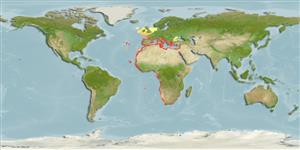Teleostei (teleosts) >
Perciformes/Serranoidei (Groupers) >
Serranidae (Sea basses: groupers and fairy basslets)
Etymology: Serranus: Latin, serran, serranus, saw and a fish of genus Serranus (Ref. 45335).
More on author: Linnaeus.
Environment: milieu / climate zone / depth range / distribution range
Ecology
Marine; demersal; depth range 5 - 500 m (Ref. 5506). Deep-water; ? - 26°C (Ref. 130590); 57°N - 35°S, 32°W - 36°E
Eastern Atlantic: English Channel southward round the Cape of Good Hope to Natal, South Africa (Ref. 4319), including Azores, Madeira and the Canary Islands (Ref. 5506). Also in the Mediterranean and western Black Sea and possibly in the Red Sea (Ref. 5506).
Length at first maturity / Size / Weight / Age
Maturity: Lm 13.7 range ? - ? cm
Max length : 40.0 cm SL male/unsexed; (Ref. 5506); common length : 25.0 cm TL male/unsexed; (Ref. 36731)
Found on the shelf and upper slope on rocks, Posidonia beds, sand and mud bottoms (Ref. 5506). Adults feed on fishes, cephalopods and crustaceans (Ref. 27121).
Tortonese, E., 1986. Serranidae. p. 780-792. In P.J.P. Whitehead, M.-L. Bauchot, J.-C. Hureau, J. Nielsen and E. Tortonese (eds.) Fishes of the north-eastern Atlantic and the Mediterranean. UNESCO, Paris. vol. 2. (Ref. 5506)
IUCN Red List Status (Ref. 130435: Version 2024-2)
Threat to humans
Harmless
Human uses
Fisheries: minor commercial; gamefish: yes; aquarium: commercial
Tools
Special reports
Download XML
Internet sources
Estimates based on models
Preferred temperature (Ref.
123201): 11.2 - 18, mean 14.4 °C (based on 327 cells).
Phylogenetic diversity index (Ref.
82804): PD
50 = 0.5000 [Uniqueness, from 0.5 = low to 2.0 = high].
Bayesian length-weight: a=0.00933 (0.00819 - 0.01064), b=2.98 (2.94 - 3.02), in cm total length, based on LWR estimates for this species (Ref.
93245).
Trophic level (Ref.
69278): 3.4 ±0.3 se; based on diet studies.
Generation time: 5.7 (3.6 - 7.2) years. Estimated as median ln(3)/K based on 13
growth studies.
Resilience (Ref.
120179): Medium, minimum population doubling time 1.4 - 4.4 years (K=0.1-0.3; tmax=6).
Fishing Vulnerability (Ref.
59153): Moderate to high vulnerability (55 of 100).
Climate Vulnerability (Ref.
125649): Low vulnerability (6 of 100).
Nutrients (Ref.
124155): Calcium = 27.3 [13.7, 76.3] mg/100g; Iron = 0.515 [0.168, 1.123] mg/100g; Protein = 17 [15, 19] %; Omega3 = 0.397 [0.212, 0.744] g/100g; Selenium = 16.3 [6.9, 37.6] μg/100g; VitaminA = 18.4 [3.7, 96.1] μg/100g; Zinc = 0.419 [0.279, 0.660] mg/100g (wet weight);
